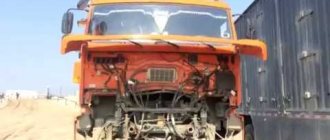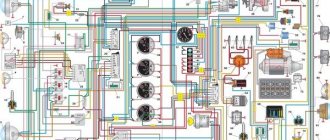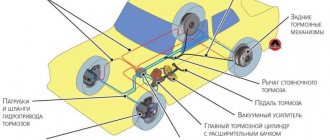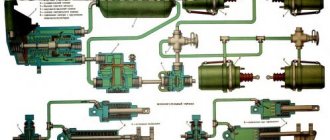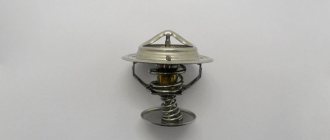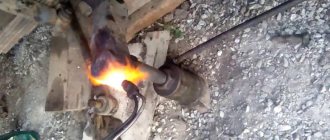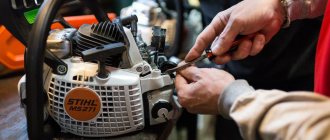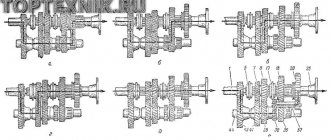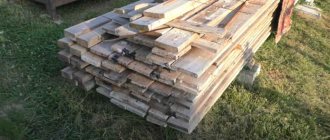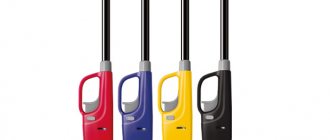How to lift the body on a dump truck
Dump trucks are very popular special equipment that is used to transport various goods. They are used both as construction equipment and to solve other problems. There is a huge number of these devices, which differ both in body type and technical indicators.
By visiting the special equipment portal, you can learn more about this category of mechanisms. A detailed description will allow you to compare all the main criteria and make the right choice.
Main characteristics
Let's look at the principle of lifting a dump truck body using a KAMAZ vehicle as an example. To understand how this works, you need to know the main characteristics of the nodes that are responsible for these actions.
The mechanism that carries out the lifting is hydraulic and consists of several parts:
- Power take-offs.
- Special pump and hydraulic distributor with hydraulic cylinder.
- It also includes a special limiting valve, a pneumatic block, an oil tank and a system of hydraulic and pneumatic piping.
Features of electrical equipment
Now let's move on to the description of the KAMAZ electrical circuit.
All models of KAMAZ 6520, 55102 and other trucks are equipped with the following subsystems:
- Starting the power unit.
- Turning lights and hazard warning lights.
- Heating unit, power supply system, windshield cleaning mechanism.
- Vehicle interior lighting.
- Head lighting. It includes low and high beam headlights, fog lights if they are installed on the car, brake lights, and dimensions.
- Tidy. This node is considered one of the main ones in the on-board network, since it contains the main sensors, devices and instruments, including a tachometer, speedometer, fuel level sensor, etc. In addition, the control panel has light indicators that turn on when the lighting is activated , handbrake, etc. Thanks to the indicators, the driver can indirectly determine the status of some components.
- Vehicle anti-theft system, if installed.
- Fuse block. This component protects the car's electrical circuits from possible voltage surges. It contains fuses responsible for the operation of the main electrical equipment.
- A control unit, thanks to which the normal operation of the main units and equipment of the car is guaranteed.
- Audio system, if the car is equipped with one.
In order for the KAMAZ electrical circuit to operate in normal mode, the condition of the wiring must be at least satisfactory.
In addition, the operation of the electrical circuit is possible if:
- Rechargeable batteries. There are two of them in KAMAZ vehicles, they are connected to each other in series. The positive terminal of the battery is connected to the starter terminal, and the negative terminal is connected to the switch, and through it to the vehicle body. Both batteries are mounted in a special box located on the machine frame, behind the cab. Thanks to the batteries, normal operation of the ignition is ensured when the engine starts. In addition, thanks to the battery, it is possible to operate electrical equipment when the engine is turned off.
- Generator. The generator unit allows you to power electrical devices and systems while the engine is running. In addition, the battery is charged using the generator unit.
1. Diagram of hazard warning lights and turning lights
2. Scheme of car lighting and optics
3. Diagram of the stove, washer and power supply
Raising the body
The procedure for raising this mechanism consists of several stages:
- First of all, we turn on the clutch and the electromagnet of type “A”, which is located on the pneumatic block. It is intended to control the power take-off.
- Then you should turn on the second electromagnet “B”. It is intended to control the hydraulic distributor. This will cause the air in the pneumatic system to flow to a specific cylinder of the hydraulic distributor. This will create pressure and cause the body to lift.
You can stop the lifting by simply turning off the type “B” magnet, but this will lead to stopping the movement and not lowering the device.
If you want to lower the raised body, then use a special electromagnet “B” for this.
After complete lowering, you need to turn off all previously switched on devices and move the handles on the pneumatic distributor to their original position.
When lifting the body, you must always monitor this process and diagnose all major components for damage, leaks and other signs. This will allow you to ensure timely shutdown of all systems and prevent emergency situations.
If the lifting system is broken, then the operation of the body and its deliberate lifting are generally prohibited.
There are also ways to carry out this procedure, which depend on the specific model of the dump truck and its technical equipment.
And in this video, those interested can take a dump truck driving master class:
How to determine the malfunction?
There are several options for diagnosing the health of a car's electrical circuit, which can be done at home. For example, you can check the presence of voltage in a certain area; for this you can use a multimeter or a test light.
So, if the circuit is faulty, the procedure is as follows:
- First, you need to connect one of the probes of the tester or warning lamp to the “-” terminal of the battery; it can also be connected to the truck body.
- The second probe must be connected to the connection of the area being diagnosed, and it is desirable that it be installed as close as possible to either the battery or the fuse.
- If, as a result of the connection, the control light starts to light up or voltage appears on the multimeter display, this means that this section of the circuit is working normally. That is, all elements are connected as needed, and no wiring repairs are required. But it must be taken into account that in some circuits voltage may be present if the ignition key is turned to a certain position.
- Next, the remaining sections of the circuit are diagnosed, the procedure is carried out in a similar way.
- If you find a point where there is no voltage, then most likely the cause of the problem lies between this point and the last area where there is voltage.
- It should be noted that in most cases, problems with wiring are caused by poor contact.
Wiring diagnostic tester You can also try to find a short circuit in the system at home:
- First, you need to remove the safety element responsible for the circuit being diagnosed from the socket.
- Then the tester needs to be switched to voltmeter mode.
- One probe of the device must be connected to the fuse connection terminals. In this case, all devices and devices of this circuit must be turned off and de-energized.
- Then try moving the cable. If values appear on the display at this moment, this indicates a short circuit. As a rule, this problem appears as a result of chafing of the insulation on the wire (the author of the video is Grigory Sergeev).
KAMAZ dump truck platform design
This platform is all-metal and welded, has a canopy for protection, a side at the back that opens, and locks for this side. It is heated by exhaust gases, which helps prevent cargo from freezing in winter.
The equipment includes a platform, a lifting and lowering system, and a subframe. The latter is a welded type device, including 2 spars, a reinforcement, and cross members. The lifting and lowering mechanisms of the platform cover:
- A power take-off box with a pump. They take power from the gearbox.
- The high-pressure pump is gear-type and provides oil flow at a speed of 85 liters per minute and a rotation speed of 1920 rpm.
- Hydraulic cylinder (belongs to the telescopic type and has a one-way action).
- A block by means of which the liquid pressure in the tipping mechanism is controlled, including an electric pneumatic valve and a control valve.
- A valve that limits the level of lifting of the platform, stopping the lifting when it reaches the greatest angle.
- An oil tank made by stamping from 2 halves, having filters, the locations of which are a filler neck with a drain line.
- A stabilizer that holds the platform during unloading, avoiding movement in the transverse direction.
KamAZ 65115
KamAZ 65115 – photo 1
KamAZ 65115 – photo 2
KamAZ 65115 – photo 3
KamAZ 65115 – photo 4
KamAZ 65115 – photo 5
How the platform works
The mechanism for lifting it is hydraulic. It covers: power take-off box (PTO); pump; hydraulic distributor; hydraulic cylinder; valve to limit the level of platform lift; pneumatic block; an oil tank having a filter; wires.
To turn on the hydraulic system, which tilts the platform, the clutch is first engaged, then the electric magnet on the pneumatic block that controls the PTO. The air goes to the pneumatic cylinder, which activates the PTO. Immediately after activating the clutch, the pump is activated, the oil goes to the hydraulic distributor, and from there to the drain.
Raising the platform requires activation of an electric magnet that controls the hydraulic distributor. From the pneumatic system, the air mass goes to the pneumatic cylinder located on the hydraulic distributor, shifting the spool to the left position.
Then the drain cavity in the hydraulic distributor is blocked, after which the pressure line is connected to the cylinder line. In the event of a dangerous increase in pressure inside the line, the fuse is activated.
To stop the process of raising the platform, it is necessary to turn off the electric magnet that controls such a unit as the hydraulic distributor section. In this case, the cavity of the distributor pneumatic cylinder is connected to the atmosphere, after which the spring puts the spool in the neutral position.
The hydraulic cylinder line is closed, after which the platform stops in the raised position. There is also a connection between the discharge cavity of the hydraulic cylinder and the drain, while the oil that comes from the functioning pump is drained into the oil tank.
An electric magnet is turned on to lower the platform. At this moment, the air, leaving the pneumatic system, goes inside the other cavity of the pneumatic cylinder of the hydraulic distributor, moving the spool of the latter to the extreme right position and connecting the hydraulic cylinder line and the drain.
Adjusting the lifting mechanism
Regular checks of the valve and its regulation are necessary. This refers to a valve that limits lifting. Check how securely it is attached to the subframe. The screw must have a lock nut for adjustment, and it must also lock. The valve stem must not be bent
Oil leakage from under the rod seal is also unacceptable, as is leakage through the pipeline. In the case of a correctly adjusted maximum lifting angle of the KAMAZ platform, it is necessary that the pins of its stopper fit freely into the holes located in the brackets that relate to the subframe. You cannot operate a dump truck without violating the regulation of the body lifting angle.
To adjust the lifting angle, first unscrew the locknut from the adjustment screw. Then screw the screw completely into the rod. The platform rises to a position where its locking pins can easily enter the holes in the subframe, and in this position it must be locked using the locking pins.
The adjustment screw is unscrewed from the valve until it rests against the hydraulic cylinder, then it must be locked using a locknut. Then they unlock the platform, lowering it and raising it again. You need to make sure that the lifting stops immediately after the alignment of the pin axes and the holes in the overframe brackets.
When the KAMAZ body does not lift, you should check with your own hands how correctly you lift the platforms, as well as the condition of the hydraulic and pneumatic lines, how much oil is inside the tank, whether the pumps and switches are working properly, how the PTO works, whether there is a power supply.
Possible breakdowns of the dump platform
- The fitting requires the most attention. A malfunction can be caused by under-drilling a hole in it or by covering it with a seam. In this situation, the hydraulics can be repaired without problems. Before starting work, a cut is made near the hole in the cylinder to raise the body, due to which the work of the body is normalized.
- The reason can also be in the hydraulic cylinder. Often in this situation the body cannot be lowered or raised. It is lowered and the oil is drained from the cylinder to raise the body. Then the distributor is inspected, which often wears out to the point of rupture. A possible cause is a cuff malfunction.
- The valve located inside may also be the cause. You will probably need to replace worn out hydraulic cylinders, which are inexpensive. It takes a minimum of time.
Construction of the KAMAZ 6520 platform
ATTENTION! A completely simple way to reduce fuel consumption has been found! Don't believe me? An auto mechanic with 15 years of experience also didn’t believe it until he tried it. And now he saves 35,000 rubles a year on gasoline! Read more"
The platform on the KAMAZ 6520 dump truck is all-metal, welded, has a protective visor, an opening tailgate and automatic tailgate locks, it is heated by exhaust gases to prevent the cargo from freezing in the cold season. The dump truck equipment consists of a platform, a lifting and lowering mechanism and a subframe. The volume of the Kamaz platform is 12 cubic meters, and its tilting angle is 50 degrees. The subframe is a welded structure consisting of a pair of side members, a cross-shaped reinforcement and cross members. The mechanisms for raising and lowering the KAMAZ platform consist of:
- A power take-off equipped with an oil pump is designed to take power from the gearbox;
- Gear type high pressure oil pump. It provides an oil supply of 85 l/min with a rotation speed of 1920 rpm;
- Hydraulic cylinder (one-way telescopic);
- The control unit, which serves to control the pressure of the working fluid inside the hydraulic system of the tipping mechanism, it consists of an electro-pneumatic valve and a control valve;
- The platform lift limiting valve is used to stop the platform lifting when it reaches the maximum angle;
- The oil tank is stamped in two halves; it is equipped with filters located in the filler neck and in the drain line;
- The stabilizer serves to hold the platform during unloading to avoid lateral movements
Platform
Platform of a KAMAZ dump truck model 6520
The platform of the vehicle - the KAMAZ dump truck model 6520 - is all-metal, welded with a protective visor, an opening tailgate and automatic tailgate locks, heated by exhaust gases to prevent the cargo from freezing.
Dumping equipment consists of a platform, a subframe, a mechanism for raising and lowering the platform.
Platform volume is 12 m3, tilting angle is 50°.
The subframe is a welded structure consisting of two side members, cross members and a cross-shaped subframe reinforcement.
The mechanism for raising and lowering the platform contains:
- a power take-off box with an oil pump designed to take power from the gearbox;
- oil pump—high-pressure gear type. Pump flow 85 l/min at rotation speed 1920 min-1;
- hydraulic cylinder—telescopic, single-acting;
- the control unit, which serves to control the flow of working fluid in the hydraulic system of the tipping mechanism, consists of a control valve and an electric pneumatic valve;
- the platform lift limit valve limits the platform lift when the platform reaches the maximum lift angle;
- oil tank—stamped from two halves, equipped with filters on the filler neck and drain line;
- stabilizer for holding the platform during unloading from lateral movements.
Principle of operation
Platform lifting mechanism diagram
1 - oil tank; 2 - oil pump; 3 — power take-off; 4.6 - pneumatic cylinders; 5 — pneumatic block; 7 — hydraulic distributor; 8 — safety valve of the high pressure line; 9 — oil filter; 10 - hydraulic cylinder; 11 — damping valve of the hydraulic cylinder line; 12 — platform lift limitation valve; 13 — filter safety valve; A, B, C – electromagnets; I - from the pneumatic system; II - into the atmosphere.
The platform lifting mechanism is hydraulic and consists of a power take-off box, an oil pump, a hydraulic cylinder, a hydraulic distributor, a platform lift limiting valve, a pneumatic block, an oil tank with a filter and a system of pneumatic and hydraulic lines.
Principle of operation
The mechanism that lifts the platform is hydraulic. It consists of a power take-off box (abbreviated PTO), an oil pump, a hydraulic distributor, a hydraulic cylinder, a valve that limits the rise of the platform, a pneumatic block, an oil tank with a filter and a whole system of hydraulic and pneumatic wires.
To turn on the hydraulic systems of the platform tilting mechanism, you need to turn on the clutch, then turn on the electromagnet “A” on the pneumatic block (look at the diagram of the mechanism components just above), which controls the power take-off. The air, in this case, enters the pneumatic cylinder 4, which turns on the PTO 3. As soon as the clutch is engaged, the oil pump starts working, from tank 1 the oil flows to the hydraulic distributor 7, from which it goes to drain.
To raise the platform, you need to turn on the electromagnet “B”, which controls the hydraulic distributor section. From the pneumatic system, air enters the pneumatic cylinder 6 on the hydraulic distributor 7 and moves its spool to the left extreme position. In this case, the drain cavity in the hydraulic distributor is closed, and the pressure cavity is connected to the line of the hydraulic cylinder 10. In the event of a dangerous increase in pressure inside the pressure line, the safety valve 11 should operate.
To stop raising the platform, it will be necessary to turn off the electromagnet “B”, which controls the hydraulic distributor section. At the same time, the cavity of the pneumatic cylinder of the hydraulic distributor will connect to the atmosphere, and the spring will return the spool to its neutral position. The hydraulic cylinder line is blocked and the platform stops in its raised state. The discharge cavity of the hydraulic cylinder is connected to the drain, and the oil coming from the operating pump is drained into the oil tank.
To lower the platform, you need to turn on the electromagnet “B”. Then air from the pneumatic system enters another cavity of the pneumatic cylinder of the hydraulic distributor and moves its spool to the right extreme position, while the hydraulic cylinder line is connected to the drain, and the platform begins to lower. As soon as the platform has finished lowering, you need to turn off the electromagnets (all without exception), and the pneumatic distributor handles must be set to its original position. And when disabling the PTO, you must disengage the clutch again.
Question answer
Axial piston pumps belong to the most popular family of hydraulic pumps – rotary piston machines.
These types of pumps are represented in hydraulic systems by the largest number of possible designs and are the most popular hydraulic pumps. Their main advantages are high efficiency (high power density), the ability to operate at pressures up to 70 atmospheres and relative simplicity of design. Disadvantages are significant output pressure pulsation and high (compared to other types of pumps) cost. Gear pumps are cheap, simple and compact. The level of pulsations is small, but, unfortunately, their efficiency and service life are lower than those of axial piston ones, and the upper pressure limit does not exceed 20 atmospheres. It is this type of pump that is most often used on various auxiliary devices of vehicles. The body lowers arbitrarily when the rods are extended. Why? First of all, we would recommend checking the pressure distribution valve. Experience shows that in approximately 87% of cases it is its malfunction that leads to a similar result. What is the difference between a gear hydraulic pump and an axial piston pump?
The answer is simple - the type (design) of the liquid displacement mechanism. In other words, what tools do they use to create their excess pressure? In a gear pump, the pressure is generated by a pair of gears that are in mesh (external or internal), while in axial piston pumps this is done by pistons or plungers.
When fully loaded, the dump truck lifts only two rods. Why? There may be several reasons: 1 Insufficient pressure in the vehicle’s hydraulic system. Pressure is checked at service centers for the repair and maintenance of hydraulic equipment. As a rule, the pressure in the vehicle's hydraulic system corresponds to the maximum pressure indicated on the body lift cylinder. If the pressure values do not match, adjust the safety valve to the desired value. 2 The hydraulic pump does not produce the nominal pressure, in this case the pump needs to be replaced. 3 The most common case is overload. During the unloading process, the maximum pressure is reached in the hydraulic cylinder to which the safety valve is set and all the oil goes through this valve into the tank. Interested in whether you have a service center in the Khanty-Mansiysk Autonomous Okrug? section “About the company” item “Dealer network” contains the addresses and telephone numbers of all our partners and representatives. If you have not found a representative in your region, call the toll-free line 8-800-200-16-12. At the beginning of the working day, the body on the dump truck rises slowly, and then it seems to warm up and work normally. 1 Check the hydraulic oil for thickening; it may not correspond to the temperature conditions. 2 Check the stroke of the spool on the distributor; there may be ice on the outer part of the spool or the surface is very dirty. clean off ice and dirt and check the valve stroke. 3 insufficient pressure in the pneumatic system of the “Lifting” - “Lowering” control of the body. The air pressure in the pneumatic tubes suitable for the distribution valve must be at least 6 kg/cm2, 6 bar. 4 Check the oil valve on the hydraulic tank; it must be completely open. The first rod does not go down all the way. As a rule, this happens when the first (largest) rod is deformed. Deformation occurs at the location where the locking ring is installed, as a result of high pressure in the hydraulic system, or the rod is bent when unloading on an uneven platform. Measure the pressure, section to be replaced. When idle in the box, the body lifts. I went on a flight and it doesn’t get up. 1 check the level of hydraulic oil in the tank and check the valve on the tank, it should be in the “open” position 2 check whether air flows to the power take-off switch on 3 check whether air flows to the distributor when the joystick is in the “raise” “lower” position in the driver’s cabin 4 check the body lift limiter for the stroke of the spool, if there is one, 5 check and tighten the quick-release coupling of the hydraulic valve that goes from the tractor to the semi-trailer. 6 check the full stroke of the spool on the distributor. Hydraulic fluid is leaking from the top of the lift! most likely the sealing collars on the hydraulic cylinder are worn out (possibly due to scuffing on the working surface of the cylinder rods. The body lowers slowly, but unloads normally. 1 Pay attention to the oil filter in the tank. If it is clogged, you will have to replace it. Try to change the filter every six months 2 insufficient air pressure in the pneumatic control in the “lowering” position 3 not full stroke of the spool in the distributor in the “lowering” position, clean the spool from dirt 4 check whether the quick-release connections are completely screwed in. 5 with the body completely lowered and the pump turned off, connect the high pressure valve to the cylinder without quick release coupling, if the body begins to lower quickly, it means replacing the coupling (quick-release coupling) 6 if a hose break valve is installed on the cylinder, this may be the reason. The body either rises to the end or lowers. There is no intermediate fixation. (A.P. Pimenov, g .Samara) Dear Alexey Petrovich! Dirt or debris has gotten under the check valve on the distributor. The pressure limiting valve on the distributor is faulty. There may be a constant supply of air from the joystick in the cabin, to determine, pull out the pneumatic tubes one by one from the fittings in the distributor, with the joystick in neutral position pneumatic control. Most likely the distributor needs to be replaced. Why does the cylinder move jerkily? Remove air from the hydraulic system. Check the serviceability of the hydraulic pump. The body does not lower. There are several reasons. Eliminate the simplest one first - loosen the PCO screw. The cause may also be oil (thick?), as well as a clogged return filter. Serious breakdowns: malfunction of the pneumatic valve pusher or pneumatics. The pump does not turn on, and as a result, the body does not rise. Is the problem with the pump not delivering oil? (Leonid) Not only in him. Check whether the PTO is engaged and the pressure in the lift valve. Air is leaking from the distributor tube on the hydraulic tank. Eliminate a malfunction of the pneumatic control joystick. How can I purchase a single-circuit hydrofication kit from you? I'm interested in the standard one. Write the model and make of your vehicle. Please check whether you have a power box installed and how you plan to install the tank - on the frame or in the cab. Instead of lifting the body - a whistle. (Rinat) Tighten the quick-release coupling. It didn’t help - the problem is in the bypass valve. The replacement claims that there is nothing better than Shell Tellus T 32 oil. It seems to me that something better could be chosen for Scania. What do you think? (Boris Vladimirovich, Norilsk.) Your replacement is partly right, Boris Vladimirovich. But as an option, in your climate zone you can use SHELL TELLUS Arctic 32 hydraulic oil. Is it possible to hydraulically equip my car for TONAR? I'm interested in model 97461 with movable floors. I have a Volvo 2005. Hydrofication is possible. Most likely you need a 110 l/min piston pump. SOS! A distinct impact is heard when the body is lifted. Moreover, with reverse impact. Then rise again. (A. Egorov, Yaroslavl) Measure your blood pressure urgently. Contact the dealer in your region: phone +7 (485) 269-5252, Yaroslavl, st. Dekabristov, 2 (industrial zone) Today I watched the oil bubble and come out. More like an emulsion. This happens when the body is raised. If it is an emulsion, then perhaps moisture has accumulated in the oil. Check where the oil comes out. What to do? Check if the air filter is clogged. If the body doesn't lift, is it a hydraulic issue? It is quite possible that the pump also burned out. But first, take your blood pressure. It must match what is written on the cylinder nameplate. Doesn’t match - alas, the pump needs to be replaced. I want to use my Volvo dump truck with a trailer. Hydrofication is needed. How long will the work take? (Mikhail Dugin) Hello, Mikhail. Work for the day. The work includes replacing the tank, laying a hydraulic line and installing two valves - a bypass and a diverter. Volvo FM. What oil do you recommend for lifting for a wide range of temperatures? Select oil according to viscosity. It should be 75 mm²/s. This is for low temperatures. For extremely high temperatures, above 65 degrees (not air, but oil!) it is better to use an oil cooler.
Adjusting the lifting mechanism
It is necessary to periodically check the condition and correct adjustment of the valve that limits the lift of the platform. The reliability of the valve's fastening to the subframe cross member bracket is checked. The adjustment screw must have a locknut and be locked. The bending of the stem in the valve, oil leakage from under the stem seal, and leaks along the pipeline threads are also unacceptable. With a correctly adjusted maximum lift angle of the KAMAZ platform, its locking pins should pass freely into the holes made in the subframe brackets. It is not permissible to operate a dump truck in violation of the body lift angle adjustment.
Customer Reviews
The greatest reward and praise for our employees is satisfied customers and their positive feedback with gratitude
“This is not the first time we have contacted the service center and we are very pleased with everything. Repairs are carried out quickly, and most importantly, efficiently. The prices are very reasonable, and the staff is friendly and always ready to provide the necessary assistance.
“The hydraulic pump was faulty and oil was leaking. The technicians carried out a quick diagnosis and immediately found out the cause of the problem. We didn't have to wait long for the repairs to be completed. Very satisfied. You guys are great!”
Platform control on KAMAZ-5511
To turn on the PTO on the KAMAZ5511 dump truck, you will need to move the lever on switch 6 to the “On” position; to do this, press the lock button, which is located on the body of this switch. In this case, the clutch must be disengaged. The signal lamp 5 will light up. And the electric current through fuse 8 will flow to the winding of the electromagnet on pneumatic valve 4.3, its core will move and open the valve. At the same time, air from the receiver will begin to flow into the cavity of the 3.3 KOM pneumatic chamber, and as soon as the clutch is engaged, pump 10 (oil) begins to work.
From oil tank 12, oil will flow through a pump through a pipeline into control valve 2 and then to drain back into the oil tank. Such oil circulation helps to warm it up in cold weather, which improves the operating conditions of the hydraulic system of the tipping mechanism.
Instructions on how to lift the body of a KamAZ 5511
To raise the 5511 dump truck platform, you need to press switch button 7 “Lift” to the “On” position. From the switch, the electric current will flow to the windings of electro-pneumatic valves number 4.1 and 4.2, their cores, having moved, open these valves. From the receiver, air is supplied to pneumatic chambers number 3.1 and 3.2 on the control valve. From the control valve, oil will flow through pipelines into hydraulic cylinder 1. Under the influence of oil pressure, all links of the hydraulic cylinder will sequentially extend, thereby lifting the platform. When the platform is raised, the hydraulic cylinder gradually tilts, and when the lift angle reaches 60°, the hydraulic cylinder body presses the adjusting screw in the platform lift limit valve (number 13 in the diagram below), the oil goes through the valve to drain. At the same time, the platform will stop rising.
Now you understand how to raise the body shock absorber; the cost of incorrectly adjusting the angle of inclination is, at a minimum, a breakdown of the hydraulic cylinder.
To stop the 5511 dump truck platform in its intermediate position, when lifting or lowering, it is necessary to move the “Lifting” or “Lowering” switch key to the “Off” position. At the same time, the electro-pneumatic valves are turned off, the air leaves the working cavities of the diaphragm chambers number 3.1 and 3.2. The hydraulic cylinder line closes, the cavity of the control valve begins to communicate with the drain line, and the oil goes to drain.
To lower the dump truck body, you need to move the switch key 7 to the “On” position. The current will flow to the winding of valve 4.1, its core, moving, will open the valve. The air will enter pneumatic chamber 3.1, in the control valve. From the hydraulic cylinder, the oil will flow through the tap into the tank. After the platform is completely lowered, you should move the key on switch 7 to the “Off” position. The lever on switch 6 is also set in the neutral position, while at the same time depressing the clutch pedal. The oil pump will stop working. It should be noted that the KAMAZ-5511 body can be lowered both when the oil pump is running and when the pump is already turned off.
Forget about fines from cameras! An absolutely legal new product - Traffic Police Camera Jammer, hides your license plates from the cameras that are installed in all cities. More details at the link.
- Absolutely legal (Article 12.2);
- Hides from photo and video recording;
- Suitable for all cars;
- Works through the cigarette lighter connector;
- Does not cause interference to radios and cell phones.
Malfunction options and repairs
Our specialists conduct diagnostics before starting repairs.
Particular attention should be paid to the fitting. The cause of the breakdown may be an incompletely drilled hole at the fitting, or the seam blocking it. In this case, the hydraulics can be easily repaired. Before starting work, the craftsmen make a cut at the hole in the body of the body lift cylinder (example KAMAZ 5511), so the body begins to function normally.
Another malfunction may be a broken hydraulic cylinder. Often in this case, the body of the KamAZ 5511, and other models, may not lower or rise. In this case, specialists lower the body and drain the oil from the body lift cylinder. Then inspect the distributor as it often wears out and may burst. The cause is a faulty cuff.
If you notice that the body on your KamAZ does not rise, contact our service center in Krasnodar. We carry out the work after diagnosis. First, let's examine the distribution hose. The problem may also lie in the valve, which is located on the inside. It may be necessary to replace hydraulic cylinders that are worn out. They have a low cost. Replacing them with new ones will not take much time.
How to raise the body of a Kamaz truck is one of the most popular questions among drivers. The dump truck body is made in the form of a rising and falling platform; it is controlled not by one button, but by a system of mechanisms. To understand how to lift the body on a Kamaz dump truck, photo above, you need to know the structure of the platform, and how to control these devices, let’s start in order.
How to lift the body on a KamAZ
Dump trucks are very popular special equipment that is used to transport various goods. They are used both as construction equipment and to solve other problems. There is a huge number of these devices, which differ both in body type and technical indicators.
By visiting the special equipment portal, you can learn more about this category of mechanisms. A detailed description will allow you to compare all the main criteria and make the right choice.
Main characteristics
Let's look at the principle of lifting a dump truck body using a KAMAZ vehicle as an example. To understand how this works, you need to know the main characteristics of the nodes that are responsible for these actions.
The mechanism that carries out the lifting is hydraulic and consists of several parts:
- Power take-offs.
- Special pump and hydraulic distributor with hydraulic cylinder.
- It also includes a special limiting valve, a pneumatic block, an oil tank and a system of hydraulic and pneumatic piping.
Problem with the KAMAZ body
Is your KAMAZ body hanging up or not rising at all? Contact our service center. Very often the hydraulic system, which is responsible for the body lifting operation, has malfunctions. This problem arises due to the fact that the mechanism responsible for the operation of the body is broken and requires repair. It is a malfunction of the lifting mechanism that can lead to a problem with the body. To do this, you need to contact our repair service center. Our technicians will answer your questions and begin the repair.
Raising the body
The procedure for raising this mechanism consists of several stages:
- First of all, we turn on the clutch and the electromagnet of type “A”, which is located on the pneumatic block. It is intended to control the power take-off.
- Then you should turn on the second electromagnet “B”. It is intended to control the hydraulic distributor. This will cause the air in the pneumatic system to flow to a specific cylinder of the hydraulic distributor. This will create pressure and cause the body to lift.
You can stop the lifting by simply turning off the type “B” magnet, but this will lead to stopping the movement and not lowering the device.
Causes of failure
If an unpleasant situation occurs and the body on a KamAZ 45143 does not rise, then the reason may be the following:
- The problem may be deformation of the rod parts or wear or chafing of the seals.
- Malfunction of the hydraulic pump unit.
- Low hydraulic pressure.
- Cuff wear.
- Using low-quality oil.
- Reducing valve spring malfunction.
These are the main points that can lead to malfunction of the lifting mechanism on the body.
The body on KamAZ 45143 does not rise? Tips from KropKuzov
Our highly qualified specialists provide free recommendations and help identify and eliminate the causes of failures in the operation of various auxiliary mechanisms on bodies.
First of all, carry out a visual inspection. Make sure that there is no oil leakage; the integrity of all elements of the hydraulic pump must be maintained. The reason may be the expiration of the service life of some spare parts. It is necessary to check the main elements of the lifting mechanism for integrity and identify deformations. The body may not lift due to simple contamination or penetration of foreign objects into the valves or grooves.
KAMAZ dump truck platform design
This platform is all-metal and welded, has a canopy for protection, a side at the back that opens, and locks for this side. It is heated by exhaust gases, which helps prevent cargo from freezing in winter.
The equipment includes a platform, a lifting and lowering system, and a subframe. The latter is a welded type device, including 2 spars, a reinforcement, and cross members. The lifting and lowering mechanisms of the platform cover:
- A power take-off box with a pump. They take power from the gearbox.
- The high-pressure pump is gear-type and provides oil flow at a speed of 85 liters per minute and a rotation speed of 1920 rpm.
- Hydraulic cylinder (belongs to the telescopic type and has a one-way action).
- A block by means of which the liquid pressure in the tipping mechanism is controlled, including an electric pneumatic valve and a control valve.
- A valve that limits the level of lifting of the platform, stopping the lifting when it reaches the greatest angle.
- An oil tank made by stamping from 2 halves, having filters, the locations of which are a filler neck with a drain line.
- A stabilizer that holds the platform during unloading, avoiding movement in the transverse direction.
How the platform works
The mechanism for lifting it is hydraulic. It covers: power take-off box (PTO); pump; hydraulic distributor; hydraulic cylinder; valve to limit the level of platform lift; pneumatic block; an oil tank having a filter; wires.
To turn on the hydraulic system, which tilts the platform, the clutch is first engaged, then the electric magnet on the pneumatic block that controls the PTO. The air goes to the pneumatic cylinder, which activates the PTO. Immediately after activating the clutch, the pump is activated, the oil goes to the hydraulic distributor, and from there to the drain.
Raising the platform requires activation of an electric magnet that controls the hydraulic distributor. From the pneumatic system, the air mass goes to the pneumatic cylinder located on the hydraulic distributor, shifting the spool to the left position.
Then the drain cavity in the hydraulic distributor is blocked, after which the pressure line is connected to the cylinder line. In the event of a dangerous increase in pressure inside the line, the fuse is activated.
To stop the process of raising the platform, it is necessary to turn off the electric magnet that controls such a unit as the hydraulic distributor section. In this case, the cavity of the distributor pneumatic cylinder is connected to the atmosphere, after which the spring puts the spool in the neutral position.
The hydraulic cylinder line is closed, after which the platform stops in the raised position. There is also a connection between the discharge cavity of the hydraulic cylinder and the drain, while the oil that comes from the functioning pump is drained into the oil tank.
An electric magnet is turned on to lower the platform. At this moment, the air, leaving the pneumatic system, goes inside the other cavity of the pneumatic cylinder of the hydraulic distributor, moving the spool of the latter to the extreme right position and connecting the hydraulic cylinder line and the drain.
After this, the platform is lowered. Immediately upon completion of lowering, the electric magnets (all) must be turned off, while the pneumatic distributor handles are returned to their original position.
